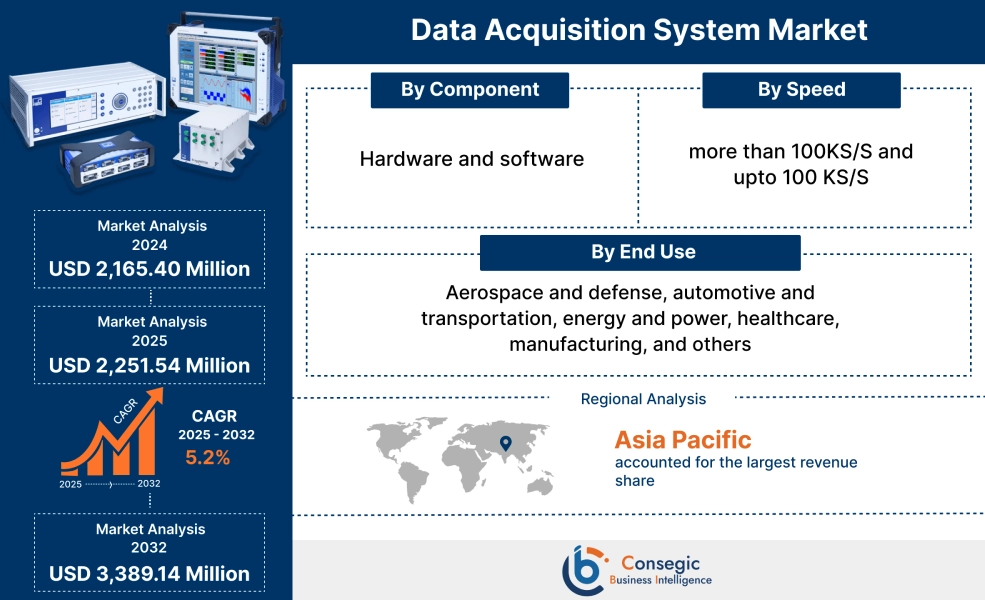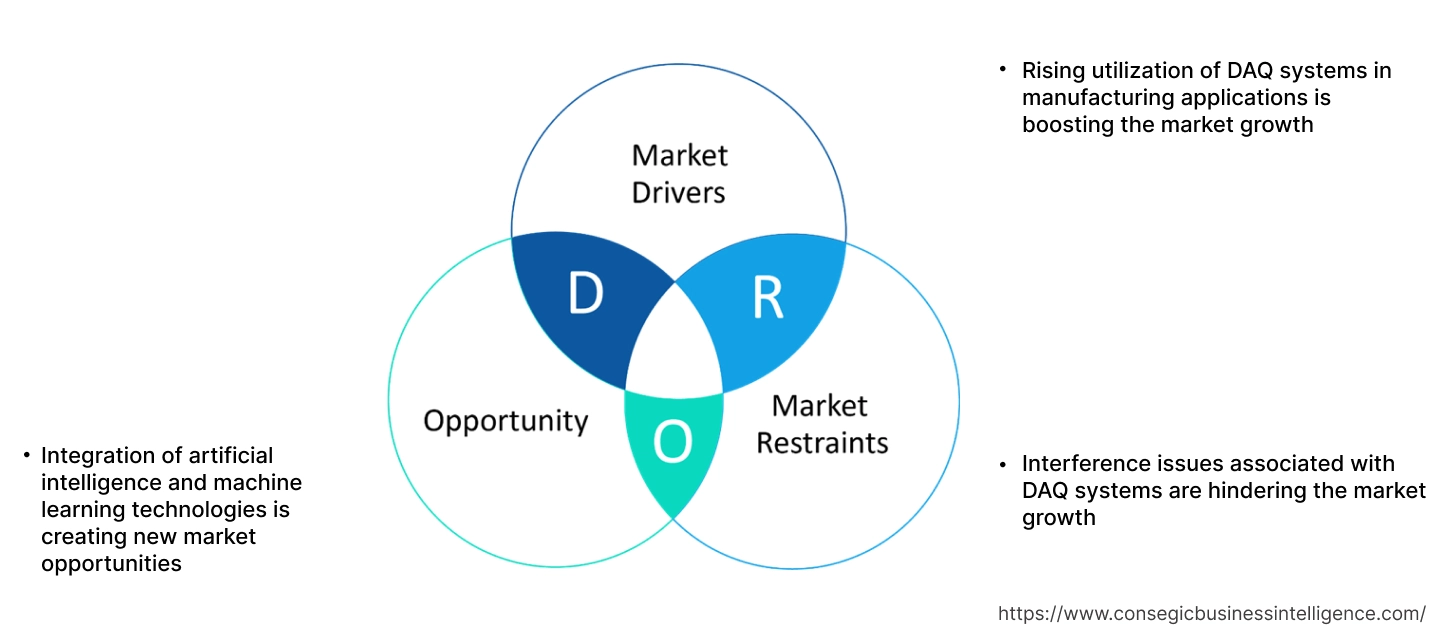Data Acquisition System Market Size:
Data Acquisition System Market size is estimated to reach over USD 3,389.14 Million by 2032 from a value of USD 2,165.40 Million in 2024 and is projected to grow by USD 2,251.54 Million in 2025, growing at a CAGR of 5.2% from 2025 to 2032.
Data Acquisition System Market Scope & Overview:
A data acquisition (DAQ) system is a setup that collects data from various sensors, converts analog signals to digital, and then stores the data for later analysis or processing. It typically includes sensors, a data acquisition device, and a computer with software. These measure physical quantities and convert them into electrical signals, such as voltage, current, or resistance and it enables immediate analysis and control of processes. The DAQ systems enable the storage and retrieval of data for later analysis. It is used to measure a wide range of physical quantities. Moreover, it automates the data collection process, freeing up human resources. Additionally, it also facilitates the visualization of data through graphs and other formats along with providing valuable data for making informed decisions.
How is AI Impacting the Data Acquisition System Market?
AI is revolutionizing the data acquisition system market by enhancing data processing, enabling real-time insights, and improving system performance. AI algorithms are being integrated into data acquisition system to perform predictive maintenance, detect anomalies, and facilitate real-time decision-making. Also, AI integration analyzes sensor data to predict potential equipment failures, enabling proactive maintenance and preventing costly downtime. Thus, AI integration leads to increased operational efficiency, reduced downtime, and a more proactive approach to problem-solving across various industries.
Data Acquisition System Market Dynamics - (DRO) :
Key Drivers:
Rising utilization of DAQ systems in manufacturing applications is boosting the market growth.
A data acquisition system, used in manufacturing, captures data from various sources to provide insights into the production process and equipment. It is crucial for optimizing efficiency, improving quality control, and enabling smart manufacturing practices. DAQ systems continuously monitor various parameters like temperature, pressure, flow rate, and machine vibration to ensure processes are running smoothly and within acceptable parameters. By tracking data related to the production process, DAQ systems help identify potential quality issues early on and enable timely corrective actions.
Thus, the aforementioned factors are further driving the data acquisition system market growth.
Key Restraints:
Interference issues associated with DAQ systems are hindering the market growth
Data acquisition systems face various interference challenges, including noise, electrostatic and electromagnetic interference, and ground loops. These interferences can distort measurements, lead to data loss, and even damage equipment. To mitigate these challenges, robust system design, proper grounding, signal conditioning, and filtering techniques are crucial. Time-varying electrical and magnetic fields induce noise, distorting measurements. Circuits with multiple ground connections create unwanted current loops, leading to noise and inaccuracies.
Thus, the market analysis shows that the aforementioned factors are restraining the data acquisition system market demand.
Future Opportunities :
Integration of artificial intelligence and machine learning technologies is creating new market opportunities
Integrating artificial intelligence (AI) and machine learning (ML) into data acquisition system enhances data collection, preparation, and analysis, leading to more efficient and effective AI and ML models. AI can automate processes like data acquisition from various sources and cleaning, while ML models are trained on prepared data to extract valuable insights and patterns. AI automates the process of ingesting data from various sources, including databases, APIs, sensors, and other digital platforms. AI automates tasks like data cleaning, transformation, and formatting, ensuring data quality and consistency for ML model training.
Thus, the ongoing advancements associated with the integration of AI and ML with DAQ systems are projected to drive data acquisition system market opportunities during the forecast period.
Data Acquisition System Market Segmental Analysis :
By Component:
Based on the component, the market is segmented into hardware and software.
Trends in the Component:
- Rising adoption of hardware components for improved efficiency, cost reduction, and enhanced decision-making by providing timely and accurate data is boosting the data acquisition system market size.
- Increasing demand for software for data collection, analysis, and reporting is driving the market.
The hardware segment accounted for the largest revenue share in the data acquisition system market share in 2024.
- A DAQ system typically includes hardware components like sensors, signal conditioning, an analog-to-digital converter (ADC), and other hardware components.
- Sensors are devices that convert physical phenomena (like temperature, pressure, or light) into electrical signals.
- Signal conditioning circuitry prepares the weak sensor signals for digitization by amplifying, filtering, and processing them.
- Analog-to-digital converter (ADC) converts the analog signals from the sensor into digital values that a computer can process.
- Plug-in boards connect directly to a computer's motherboard and provide an interface for data acquisition.
- Therefore, the aforementioned factors are boosting the data acquisition system market growth.
The software segment is expected to register the fastest CAGR during the forecast period.
- A DAQ system and its associated software work together to measure and record data from various sources.
- The software plays a crucial role in managing the data, displaying it, and allowing for analysis.
- The software is used for configuring and controlling the acquisition of data from sensors, saving the acquired data for later analysis, and presenting the data in real time or after acquisition.
- The software is also used for providing tools for analyzing and interpreting the acquired data and generating reports based on the acquired data.
- Thus, the aforementioned factors are expected to boost the data acquisition system market trends during the forecast period.
By Speed:
Based on the speed, the market is segmented into more than 100KS/S and upto 100 KS/S.
Trends in the Speed:
- Rising adoption of upto 100 KS/S systems for small-scale applications is boosting the data acquisition system market size.
- Increasing adoption of more than 100 KS/S systems to capture fast changing signals for real-time data acquisition.
The more than 100 KS/S segment accounted for the largest revenue share in the market in 2024 and it is expected to register the fastest CAGR during the forecast period.
- A high-speed data acquisition (DAQ) system refers to a system that can sample data at a rate greater than 100 KS/s (kilohertz per second).
- These systems are crucial for capturing fast-changing signals, especially in applications like dynamic testing, shock and vibration analysis, and transient events.
- These systems are designed for real-time data acquisition, allowing the immediate capture and analysis of rapidly changing phenomena.
- High-speed DAQ systems are essential for applications involving dynamic events, such as shock and vibration testing, acceleration studies, and impact events.
- Therefore, the aforementioned factors are boosting the data acquisition system market demand.
By End Use:
Based on the end use, the market is segmented into aerospace and defense, automotive and transportation, energy and power, healthcare, manufacturing, and others.
Trends in the End Use:
- Rising adoption of DAQ systems in healthcare to collect, store, and analyze patient data from various sources.
- Increasing demand for DAQ systems in the automotive sector for performance optimization, vehicle diagnostics, safety monitoring, race strategy, and post-race analysis.
The aerospace and defense segment accounted for the largest revenue share of 32.50% in the data acquisition system market share in 2024.
- Data acquisition systems are essential tools in the aerospace and defense sector, providing real-time monitoring and analysis of various parameters during flight testing, structural integrity assessments, and others.
- They collect data from sensors, convert it to digital form, and transmit it for analysis and storage, enabling engineers and researchers to make informed decisions.
- DAQ systems are crucial for collecting data during flight tests, including parameters like airspeed, altitude, and wing deformation, which are vital for aerodynamic analysis, safety evaluations, and design improvements.
- DAQ systems help monitor the structural integrity of aircraft and other aerospace systems by measuring vibration, stress, and strain, allowing for early detection of potential problems.
- Therefore, the aforementioned factors are boosting the data acquisition system market expansion.
The energy and power segment is expected to register the fastest CAGR during the forecast period.
- A data acquisition system is used in the energy and power sector to collect, measure, and process data from various sources, such as sensors, to monitor and control energy systems.
- This system helps in understanding system performance, optimizing energy efficiency, and ensuring reliable operation.
- DAQ systems are used to monitor the performance of solar panels, wind turbines, and other power generation systems, including tracking environmental conditions.
- Moreover, DAQ systems help manage energy consumption in buildings, industrial facilities, and smart grids by collecting data from meters and sensors.
- Thus, the aforementioned factors are expected to boost the data acquisition system market trends during the forecast period.
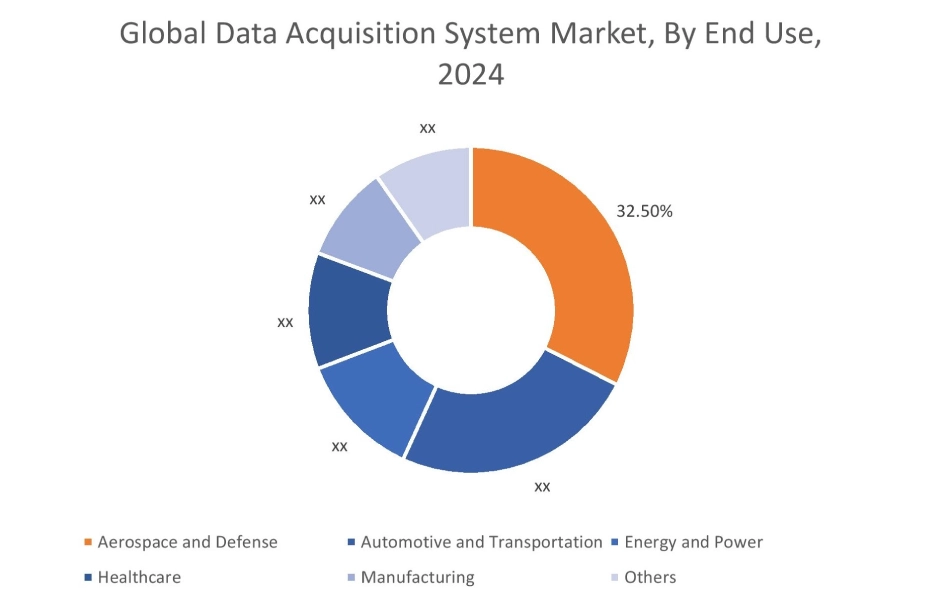
Regional Analysis:
The regions covered are North America, Europe, Asia Pacific, the Middle East and Africa, and Latin America.
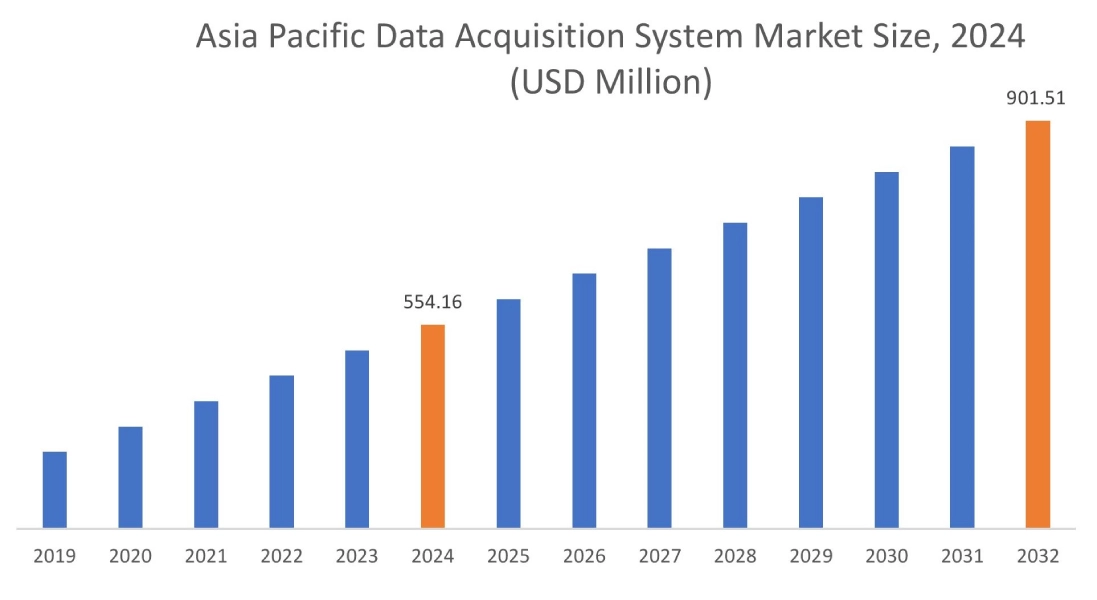
Asia Pacific region was valued at USD 554.16 Million in 2024. Moreover, it is projected to grow by USD 578.10 Million in 2025 and reach over USD 901.51 Million by 2032. Out of this, China accounted for the maximum revenue share of 32.60%. The market growth in the Asia-Pacific region is rising due to rapid industrialization, automation, and a focus on smart factories and Industry 4.0. Government initiatives and advancements in technologies like AI and IoT further fuel this growth. Key factors influencing this trend include the rise of the manufacturing sector, investments in renewable energy and electric vehicles, and the need for real-time monitoring and data analysis. Thus, the data acquisition system market analysis shows that the aforementioned factors are data acquisition system market opportunities.
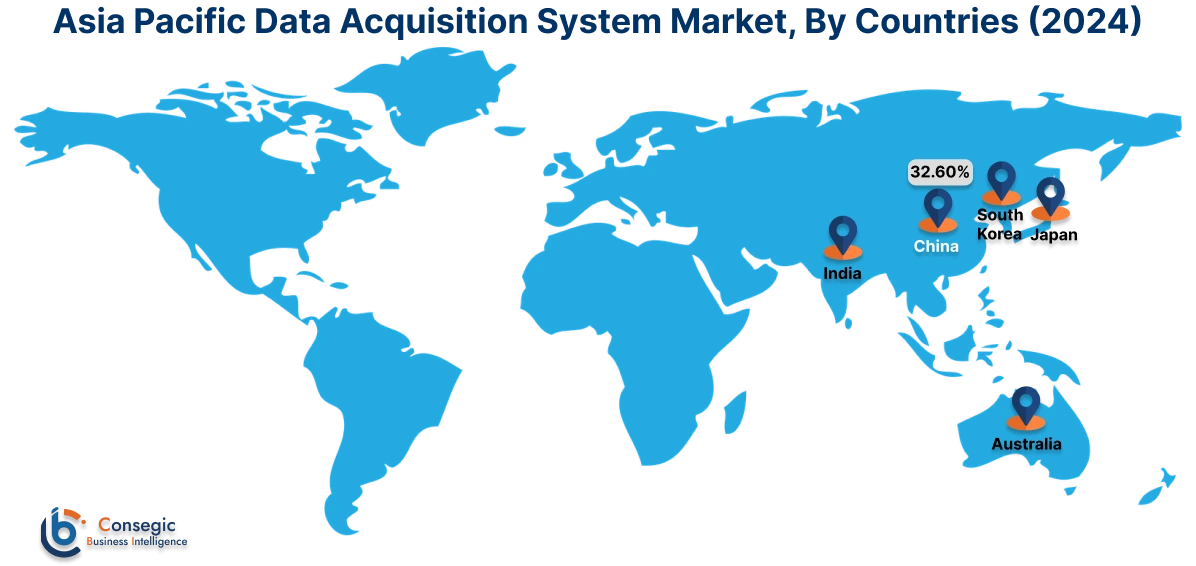
North America is estimated to reach over USD 1,433.61 Million by 2032 from a value of USD 919.93 Million in 2024 and is projected to grow by USD 956.19 Million in 2025. The market is growing due to factors including well-established aerospace and defense, energy and power, and healthcare industries that require DAQ systems to collect information in real-time.
In Europe, the market is growing due to the rising need for real-time data collection and analysis for various industries such as healthcare, energy, and others, as well as the increasing importance of data monitoring in aforementioned end-use industries. Moreover, in Latin America, and Middle East and Africa, the market is growing due to the rise of IoT and automation, increasing emphasis on data monitoring, adoption of Industry 4.0, and increasing demand for data-driven insights among others. Thus, the data acquisition system market analysis depicts that the aforementioned factors are boosting the data acquisition system market expansion.
Top Key Players and Market Share Insights:
The data acquisition system industry is highly competitive with major players providing solutions and services to the national and international markets. Key players are adopting several strategies in research and development (R&D), product innovation, and end-user launches to hold a strong position in the global data acquisition system market. Key players in the data acquisition system industry include -
- Analog Devices, Inc. (United States)
- Good Will Instrument Co., Ltd. (Taiwan)
- Keysight Technologies (United States)
- Tektronix Inc. (United States)
- HBK (Germany)
- DATAQ Instruments, Inc. (United States)
- Siemens (Germany)
- Yokogawa (Japan)
- imc Test & Measurement GmbH (Germany)
- National Instruments Corp (United States)
Data Acquisition System Market Report Insights :
| Report Attributes | Report Details |
| Study Timeline | 2019-2032 |
| Market Size in 2032 | USD 3,389.14 Million |
| CAGR (2025-2032) | 5.2% |
| By Component |
|
| By Speed |
|
| By End Use |
|
| By Region |
|
| Key Players |
|
| North America | U.S. Canada Mexico |
| Europe | U.K. Germany France Spain Italy Russia Benelux Rest of Europe |
| APAC | China South Korea Japan India Australia ASEAN Rest of Asia-Pacific |
| Middle East and Africa | GCC Turkey South Africa Rest of MEA |
| LATAM | Brazil Argentina Chile Rest of LATAM |
| Report Coverage |
|
Key Questions Answered in the Report
How big is the data acquisition system market? +
Data Acquisition System Market size is estimated to reach over USD 3,389.14 Million by 2032 from a value of USD 2,165.40 Million in 2024 and is projected to grow by USD 2,251.54 Million in 2025, growing at a CAGR of 5.2% from 2025 to 2032.
What are the major segments covered in the data acquisition system market report? +
The segments covered in the report are component, speed, end use, and region.
Which region holds the largest revenue share in 2024 in the data acquisition system market? +
North America holds the largest revenue share in the data acquisition system market in 2024.
Who are the major key players in the data acquisition system market? +
The major key players in the market are Analog Devices, Inc. (United States), Good Will Instrument Co., Ltd. (Taiwan), DATAQ Instruments, Inc. (United States), Siemens (Germany), Yokogawa (Japan), imc Test & Measurement GmbH (Germany), National Instruments Corp (United States), Keysight Technologies (United States), Tektronix Inc. (United States), and HBK (Germany).
